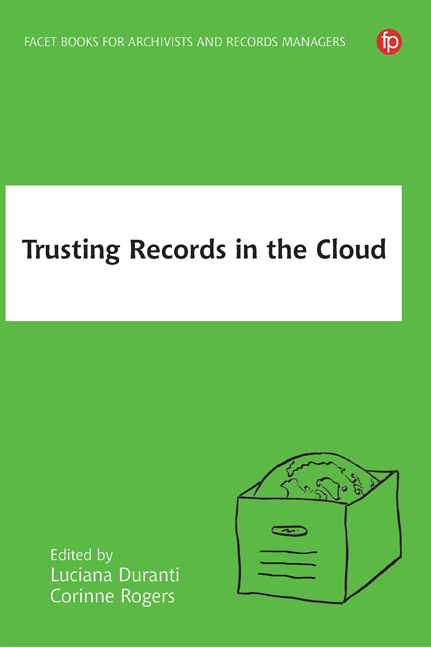Book contents
- Frontmatter
- Contents
- List of Figures and Tables
- Contributors
- 1 Introduction
- 2 The Cloud – Challenges and Issues
- 3 Open Government
- 4 Citizen Engagement
- 5 Strategies, Methods and Tools Enabling Records Governance in a Cloud Environment
- 6 Retention and Disposition
- 7 Authentication
- 8 Intellectual Control
- 9 Exploring Digital Preservation in the Cloud
- 10 Cultural Heritage – Indigenous Perspectives
- 11 The Role of the Records Professional
- 12 Education
- Appendix 1 InterPARES Trust Terminology
- Appendix 2 Products of InterPARES Trust Research
- Index
1 - Introduction
Published online by Cambridge University Press: 24 September 2019
- Frontmatter
- Contents
- List of Figures and Tables
- Contributors
- 1 Introduction
- 2 The Cloud – Challenges and Issues
- 3 Open Government
- 4 Citizen Engagement
- 5 Strategies, Methods and Tools Enabling Records Governance in a Cloud Environment
- 6 Retention and Disposition
- 7 Authentication
- 8 Intellectual Control
- 9 Exploring Digital Preservation in the Cloud
- 10 Cultural Heritage – Indigenous Perspectives
- 11 The Role of the Records Professional
- 12 Education
- Appendix 1 InterPARES Trust Terminology
- Appendix 2 Products of InterPARES Trust Research
- Index
Summary
This book presents the main findings of InterPARES Trust, the fourth phase of the InterPARES project, continuously funded by the Social Sciences and Humanities Research Council of Canada (SSHRC) since its inception in 1998. The InterPARES project is a collaboration among academics and professionals concerned about the continuing authenticity of electronic records over the long term. Hence the name Inter (among) PARES (peers), which is also an acronym for International Research on Permanent Authentic Records in Electronic Systems (InterPARES). The project name was carried on through its four phases to provide a continuing identity for the research – an overarching ongoing idea conveying its spirit and ultimate goal: the preservation of the evidentiary nature of records in different technological environments.
The overall challenges that InterPARES has addressed over 20 years were clearly identified at the outset of the project and have never substantially changed as new technologies renewed them over and over again. Gradually, the terminology changed as the adjective electronic came to be substituted by the more focused and precise digital, authentic by the more comprehensive trustworthy, and record began to be more and more frequently accompanied by data. The issues, however, stayed the same: digital records are vulnerable because they are easy to destroy, lose, corrupt and tamper with; they become inaccessible if not protected and persistent if their copies are not purposefully destroyed. Furthermore, digital records are not clearly and uniquely placed into a documentary context; their content, structure and form are not inextricably linked; and as stored entities they are distinct from any of their manifestations on a screen. When we save a digital record, we take it apart in its digital components, and when we retrieve it, we reproduce it from those components, thus creating a copy. Hence, it is not possible to preserve a digital record but only the ability to reproduce or recreate it (Duranti & Thibodeau, 2006).
Additional challenges presented by the digital environment relate to establishing digital records’ accuracy, reliability and authenticity (i.e. trust - worthiness) and maintaining them over time so that the records’ trustworthiness will be verifiable and provable:
• Developing an infrastructure that ensures a seamless controlled flow of trustworthy data/documents/records from the creator to the preserver and the user irrespective of changes in technology
• Providing transparency while protecting secrecy where warranted
Information
- Type
- Chapter
- Information
- Trusting Records and Data in the Cloud , pp. 1 - 12Publisher: FacetPrint publication year: 2018
